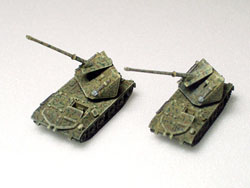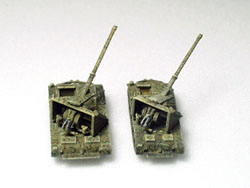Development of Leichte Einheitswaffenträger
( Light Standardized Weapon Carriage)
In April 1944, German ordnance department decided to make any heavy anti-tank gun to be self-propelled because they were too heavy to move for their crew. An order for designing a mobile gun carriage was issued. The basic requirement for the gun carriage was that the gun, either a Pak 40, Pak 43 or F.H. 18/40, had to be able to fire 360 degrees while mounted on the chassis and the gun itself can be dismounted when a fix stronghold was desired. The gun-less chassis can then be used as as reconnaissance vehicle, ammunition carrier, and artillery prime mover.
Ardelt and Rheinmetall among others built the first prototype and tests were conducted.

Based on these tests an improved prototype was produced by Ardelt and Krupp which won the production contract. Ardelt used reliable components of the 38 (t) to construct a non-standard chassis. It was not a standard 38 (t) chassis. The anti tank 88mm Pak 43 it carried was modified so that the can elevate to a 40 – 45 degree angle so that it can double as a field gun as required by the production contract. A contract of 100 vehicles was issued.


In October 1944 German Panzerkommission decided to standardize future Panzer production to use only 3 types of chassis, the 38 (t), Panther and Tiger. Unfortunately the 38 (t) chassis was poorly suited for production by German industries and supply seriously fell short of the demand. A new leichter (light) chassis was redesigned for German production based on the 38 (t) and mounting a new 220 hp Tatra diesel engine. The new chassis was named as 38D, also known as Pz. 38 “Reich”.
But before Ardelt can receive any 38D components, it was ordered in mid February 1945 to produce the Waffenträger for the immediate defense of Ederswalder. Seven vehicles were completed still using the non-standard 38 (t) chassis and only one survived the war and is now on display in the Kubinka tank museum of Russia.

If production was not stopped by the end of the war, the mass produced leichter Waffenträger would be using the 38D chassis. Major visual difference to the Kubinka vehicle would be the wider 38D chassis and the addition of a fifth seat on the right behind the gun shield for the fifth gun crew as suggested after the testing of the prototype. The center of rotation of the Pak 43 would have to move further back the hull to allow for the wider gun shield.
38D (Left) vs Kubinka vehicle (Right)
 |
 |